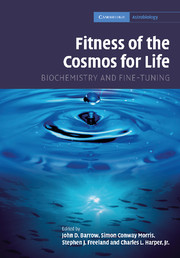Book contents
- Frontmatter
- Contents
- List of contributors
- Foreword: The improbability of life
- Preface
- Acknowledgments
- Part I The fitness of “fitness”: Henderson in context
- 1 Locating “fitness” and L. J. Henderson
- 2 Revisiting The Fitness of the Environment
- 3 Is fine-tuning remarkable?
- 4 Complexity in context: the metaphysical implications of evolutionary theory
- 5 Tuning fine-tuning
- Part II The fitness of the cosmic environment
- Part III The fitness of the terrestrial environment
- Part IV The fitness of the chemical environment
- Index
- References
2 - Revisiting The Fitness of the Environment
Published online by Cambridge University Press: 18 December 2009
- Frontmatter
- Contents
- List of contributors
- Foreword: The improbability of life
- Preface
- Acknowledgments
- Part I The fitness of “fitness”: Henderson in context
- 1 Locating “fitness” and L. J. Henderson
- 2 Revisiting The Fitness of the Environment
- 3 Is fine-tuning remarkable?
- 4 Complexity in context: the metaphysical implications of evolutionary theory
- 5 Tuning fine-tuning
- Part II The fitness of the cosmic environment
- Part III The fitness of the terrestrial environment
- Part IV The fitness of the chemical environment
- Index
- References
Summary
In 1913, long after Charles Darwin had argued for the fitness of organisms for their environment, the Harvard chemist Lawrence J. Henderson pointed out that the organisms would not exist at all except for the fitness of the environment itself. “Fitness there must be, in environment as well as in organism,” he declared near the outset of his classic work, The Fitness of the Environment (1913, p. 6). While most of Henderson's contemporaries ignored the philosophical implications of this work, as John Barrow and Frank Tipler have noted, it “still comprises the foundation of the Anthropic Principle as applied to biochemical systems” (1986, p. 143).
Henderson pointed out the uniqueness of hydrogen, carbon, and oxygen in the chemistry of living organisms. Another two decades would pass before astronomers would establish that these were three of the four most abundant elements in the cosmos; but Henderson was at least aware that these atoms were commonly found in the stars and planets. In his treatise, he began with the properties of water, just as William Whewell had done eight decades earlier in his far more teleologically oriented Bridgewater Treatise (1833).
Henderson grouped the notable qualities of water under two headings: (1) thermal properties and (2) interaction with other substances. As far as he was concerned, these were empirical, observed properties with minimal theoretical explanation. (Remember that Rutherford's nuclear atom was still a future concept, while quantum mechanics and the nature of the hydrogen bond lay many more years ahead.)
- Type
- Chapter
- Information
- Fitness of the Cosmos for LifeBiochemistry and Fine-Tuning, pp. 20 - 30Publisher: Cambridge University PressPrint publication year: 2007



